A REUNION IN BRAZIL
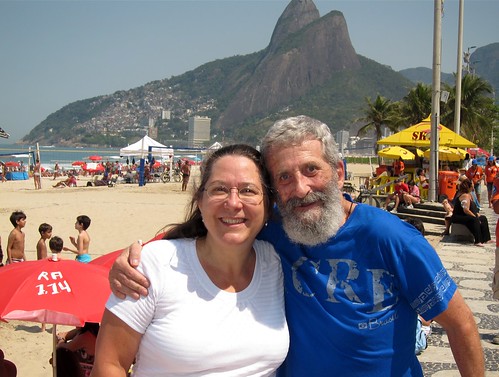
Kelpie and Lou at Ipanema beach in Rio de Janeiro
Kelpie Wilson and I have known each other for nearly 40 years, all the way back to the 1973-74 academic year at the University of Illinois where she was a politically-oriented freshman and I was the out-going "radical" professor who had become that year's "campus cause." Somehow, without even knowing each other personally we were destined to struggle for the same forest cause. As they say in Brazil, we were companheiros.
Back then we soon went our separate ways -- she to leave school to be an auto mechanic and then to return to school in California to become a mechanical engineer; I to leave school to be a carpenter/woodworker and then a backwoods guy in Oregon. We met again as we were both drawn to defense of the Siskiyou National Forest and the Kalmiopsis Wilderness. In the late 1980s Kelpie joined the Siskiyou project as a networker and rose to be its executive director and my boss. I was the storyteller and hermit. She was the one who stayed in the office and made things happen.
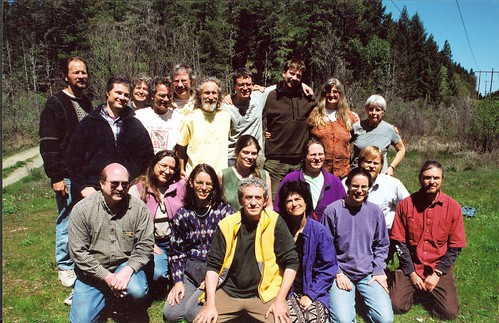
Siskiyou Project and friends (2001).
As the Clinton-Gore years passed to Bush-Cheney, Kelpie and her husband George perfected their owner-built off-the-grid home and she got busier than ever -- writing a novel and manuals for an alternate energy company and then becoming the environmental editor of truthout.org. Meanwhile, I started to spend more and more time in Brazil where I depended on the Internet for news from the States. My "filter" was mostly the articles that Kelpie selected as "important." One day her story about terra preta/biochar arrived and I was hooked.
Indeed, it was the terra preta vision that brought us both to the 3rd International Biochar Initiative meetings in Rio de Janeiro in September -- she as the IBI communications editor and I as a forest defender fascinated with Amazônia and its cultures.
Following the Rio meetings, Kelpie traveled to Manaus for a field trip to sites of terra preta de índios (photo essay here and here) where she listened to "Happy Birthday" being sung to her as she stood in a terra preta research pit.

Kelpie in the pit.
After Manaus, Kelpie traveled to far western Brazil to visit my new stomping grounds in Acre (bordering with Bolivia and Peru) where we spent time in the state capital of Rio Branco and in the countryside of Capixaba.
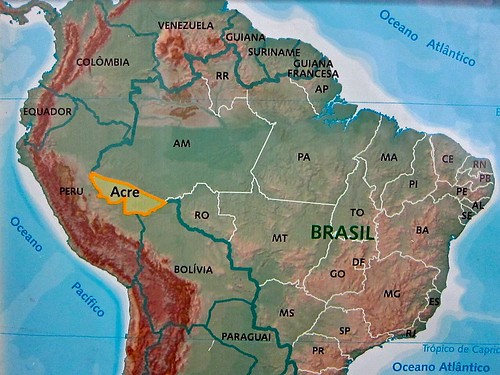
Nowadays, Acre is leaping into the 21st Century. In A Walk Through Time in Rio Branco I wrote:
In Brazil, where global warming was barely on the public agenda only a year ago, a new national political debate about sustainable development has emerged along with a growing awareness of global interrelatedness at every level – cultural, economical, ecological and political. Finding the sustainable balance among the many contradictory and opposing forces has already emerged as a major theme of the 2010 presidential election in Brazil and has erupted at Copenhagen.
I have no "crystal ball" to see the future but one thing does seem certain. The pace of change and development is moving faster and faster. Today, the rainbows and satellites are rising above the homes of Rio Branco and across Amazônia.
The 21st Century is about information. And the information is making us aware of our common planetary predicament. It is also giving us unparalleled opportunities to participate in creating the future for life on earth.
Kelpie came to gain and share information -- to learn from the people of this place and to bring news about terra preta and the new biochar tools.
With Flavio Encarnação as our guide, we started with the historical site of one of the early districts of Rio Branco and witnessed the old ways of gathering and curing rubber:
With the archeologist and geolyph researcher Alceu Ranzi, we visited a few of the 100s of archeological sites (ironically being revealed as a result of deforestation) that date back to the ancient inhabitants who are thought to have been here 1,000 to 2,000 year ago.
And then on to spend a few days at the community of Fortaleza in the rural district of Capixaba. Although Acre has approximately 80% of its land still in forest, the eastern portion of the state has been particularly hard hit as shown in this map of the deforestation up until 2006 (releasing 100 million tons of carbon).
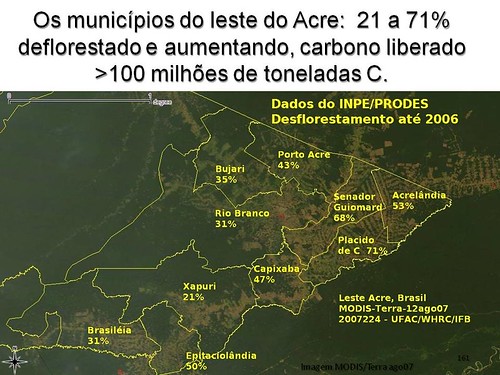
I have previously written of my struggles to confront the dilemmas of development in this region (Chico Mendes, Capixaba and Change and Walking in Beauty). At the time, Kelpie commented with great empathy on both of those posts and concluded, "I think that engagement is what is important, not the ultimate outcome, which we will never know." Now she was here to see for herself.
It was a rough introduction traveling from the town of Capixaba to the rural site of Fortaleza -- 15km on a motorcycle across dusty roads through clearcut landscapes parched from the drought and under smoke-laden skies from the regional fires. What a relief to arrive at Fortaleza (the Fortress) where there's an on-going effort at small-scale farming combined with preserving the remaining forest.
When she saw the abandoned pottery kiln, of course she said, "this needs to be making biochar."
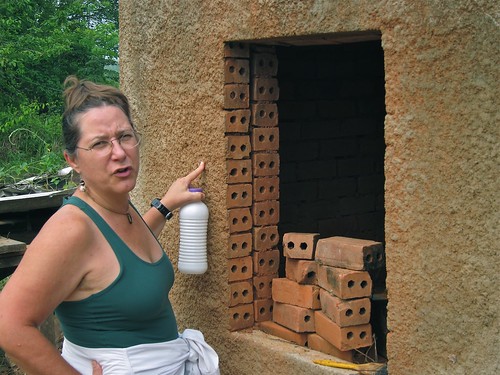
Probably, our most fun experience came during an afternoon canoe trip on the Xipamanu river which borders with Bolivia. The day was hot despite the fact that the sun was nearly obscured by smoke and due to the drought the river was too low to use the motor on the big dugout canoe which had to be pushed along with poles and dragged over submerged logs. A round-trip that normally takes about 2 hours took more than 5 and we returned well after dark. It was quite an adventure but each little challenge or disaster was greeted with laughter and harder work. Kelpie and I agreed about the result, it was one of the best river trips ever!
Returning to Rio Branco, Kelpie began a series of biochar presentations. It started slowly with just a few folks in attendance at the library of the forest.
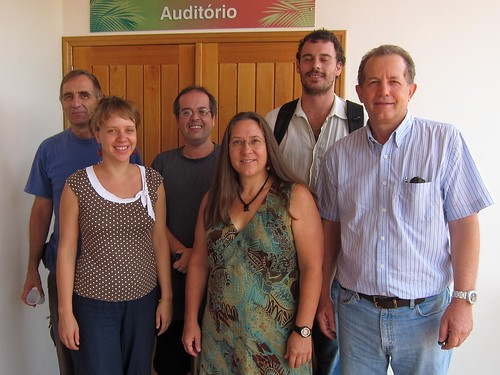
But they surely spread the word and Kelpie's presentation at the Secretariat of the Environment brought out 15 people and all 3 local TV channels.
And next came the AgroForestry Extension and Family Production Service where 40 specialists were fascinated by biochar's potential for applications in Acre.
On the way to the airport, at lunch with Janaina, Luis, and Yara, Kelpie managed to squeeze in one last presentation and it all ended at the airport with a happy farewell and fond wishes that she will return.
And what was the impact of this flurry of activity?
Just a few days after her departure, Flavio Encarnação, who is a professor of theater and who volunteered to be Kelpie's local translator, was himself giving a biochar presentation to the director of the Chico Mendes Park during the local 10/10/10 Climate Change Work Party which drew 75 to carry forth the work.
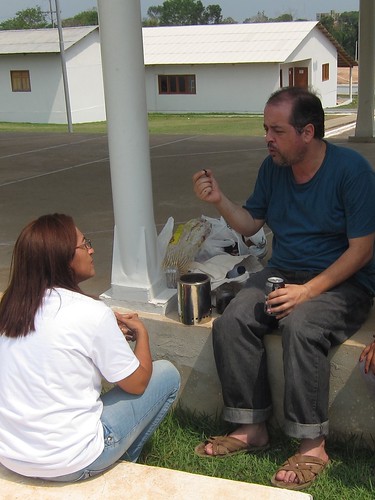
As Kelpie said, "I think that engagement is what is important, not the ultimate outcome, which we will never know."
What is clear is that Kelpie planted some good seeds and many Acreanos are grateful for her visit.






4 comments:
Lou, I want to thank you for the extremely informative and well-designed blog about Kelpie's trip! And the pictures are quite amazing. I applaud you, Kelpie and the whole bio-char effort.
Sincerely, Emma Shook, George's daughter, from Cleveland Heights, Ohio.
Dear Lou, Thanks for posting such an excellent story of Kelpie's visit to Brasil. It was vividly colorful and fascinating. The beauty of the internet is how quickly the information flows around the world. The Bio-char work that Kelpie is doing is bringing solutions for new age farmers. Amazing to see her help save the Amazon rain forest and people. It is great to see you smiling together, against the Rio backdrop.
Love, Kindi
really excellent Lou!
Hello Lou, thanks for passing on this story and accompanying photos about Kelpie's visit. It seems to have been a successful journey for Kelpie and those that she shared her extensive knowledge with. Kelpie, you are a bright light amidst the darkness of these times! I'm glad that the two of you got to be together again. Joya
Post a Comment